MINERAL RESOURCES AND ASSET MANAGEMENT
MINERAL RESOURCES AND ORE RESERVES 2012 BDP
Business and Development Plan
Codelco prepares an annual Business and Development Plan that has short, medium and long-term projections.
This Plan includes cost, expenditure and income flows, investments and funding generated during this period, based on the Mining Plan, required to extract all the mineral resources and reserves that sustain the business during the period covered. The Plan also incorporates market, mineral resources, strategic, environmental, financial, technical, contractual and other restrictions faced by the company, as well as the risks it has decided to take on.
As of this year the Triennial Plan is based on the above plan, which is then submitted to the Ministries of Mining and Finance for consideration, under the terms specified by the new Corporate Governance in effect since 1 March 2010.
Mineral Resources and Ore Reserves
In accordance with the standard practice in the industry, Codelco divides its mineral inventory in geological resources, mineral resources and ore reserves.
Geological Resources (measured, indicated and inferred) are mineral concentrations identified and estimated through exploration, geological evidence and sampling. If the resources are of economic interest and are backed by a mining plan, then they are known as mineral resources.
Reserves represent the measured and indicated mineral resources that are economically mineable, based on productive, technological and sustainable factors included in a mining plan.
In 2005, Codelco established a new criterion to divide Geological Resources, Mineral Resources and Mineral Ore Reserves for its deposits, through the Codelco Corporate Standard no. 31 revision 1 (NCC31). - updated in December 2011. This standard is based on three main pillars: data quality, geological continuity and confidence in resource estimate.
This classification provides global measurements applicable to all Codelco Divisions; a comprehensive and auditable monitoring system of the classification process, and a control tool to determine the quality of the geological modelling and estimation process. The classification criteria for Codelco resources require at least one sample drilling to define it as an inferred resource.
Therefore, Codelco applies the same classification scheme at all divisions. This scheme is in line with the definitions in the Australasian Joint Ore Reserves Committee Code - JORC - (adopted by Codelco as a benchmark), for mineral resources, proved and probable ore reserves and artificial deposits (ore stockpile and broken ore) Additionally, Codelco reports in its inventory the in situ geological resources with a cut-off grade of 0.2% CuT.
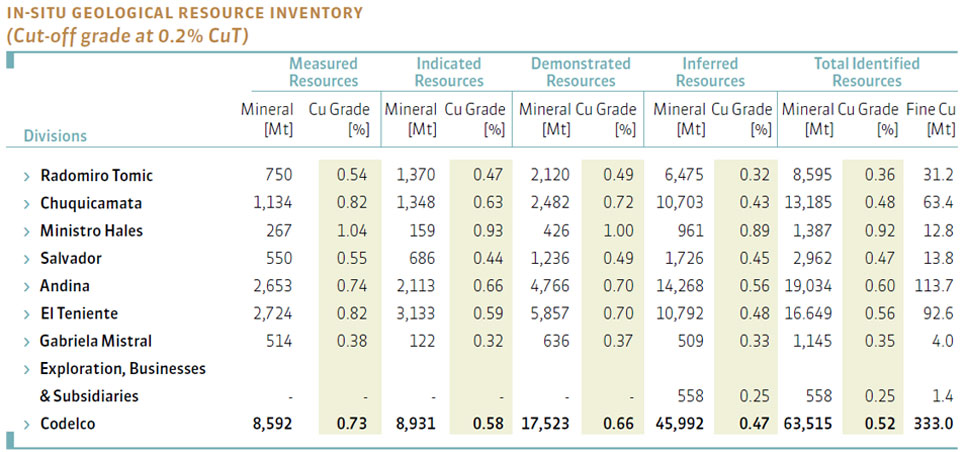
Resource Inventory in Artificial Deposits
(Cut-off grade at 0.0% CuT)
Artificial ore deposits consist of:
Broken ore: resource not extracted; remains of total or partial extraction in underground mining.
Ore Stockpile: remaining resources extracted and heaped into piles, as a result of past and future operations of open-pit mining; it depends on the cut-off grade defined in the mining plan (short and long term). Stockpiles are also subdivided into tailings and spent ore.
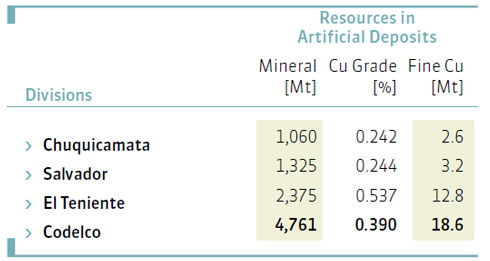
2011 geological resources increased by 3% in fine copper over 2010, as the sulphide model was updated at Radomiro Tomic, the Quetena and Genoveva resource models (Chuquicamata Division) and the incorporation of the remaining resources from Rajo Inca at Salvador Division. In turn, the resources from artificial deposits increased by 6.3% in fine copper.
Mining Plan
The Business and Development Plan is based on the mining plan for the entire life of mine. Therefore, it considers all of the mineral resources, minerals economically mineable, including those that are not proved or probable reserves, since the studies have still not been completed.
The need to transform resources into reserves occurs gradually and declines over time, in accordance with the criteria set by Codelco. As of 2011, requirements increase 100% of proved and probable reserves for the first three years of the mining plans; therefore, the divisions have started a process to improve the geomining- metallurgic base in order to comply with this requirement.
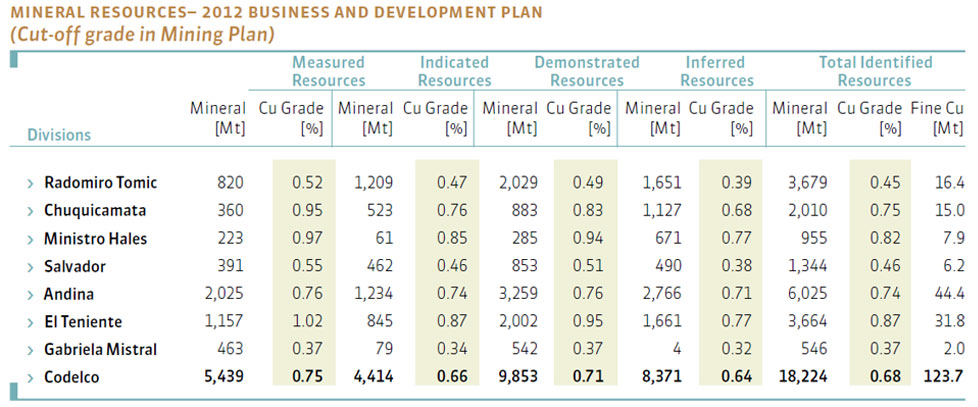
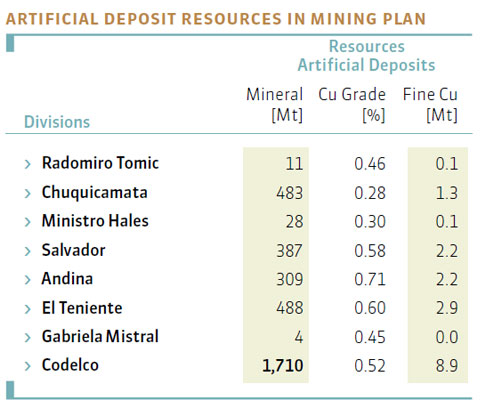
Mineral resources (2012 Business and Development Plan), that include identified mineral resources and artificial deposits, had a positive variation of 6.5% and 12.7%, respectively, in fine copper compared to the 2011 Plan, after the mining plans were updated at all Divisions and Rajo Inca was included in Salvador Division.
Production for the first 12 years is sustained nearly exclusively on proved and probable reserves; in turn, artificial deposits are also included (broken ore or stockpile) in the mining plans, at a maximum percentage of 20-25%, prior analysis of material origin and characteristics.
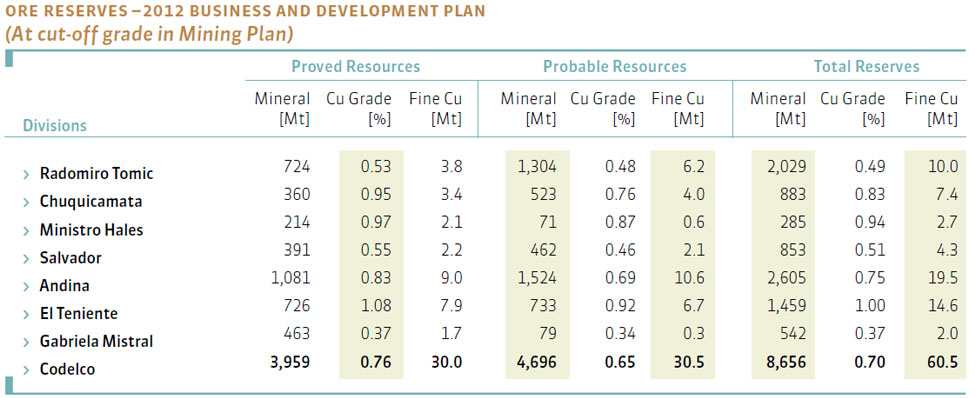
Ore reserves (proved and probable) in the 2012 Business and Development Plan were up 6% in fine copper content compared to the 2010 Plan, despite consuming approximately 1.7 mt of fine copper in the 2011 annual production.
The above indicates that Codelco has been able to replace its reserve consumption corresponding to its annual production plan, through an adequate programme that includes test drilling, analysis, interpretation and geological, mining and metallurgical modelling, as well as engineering and environmental impact studies which have helped to transform resources into reserves.
